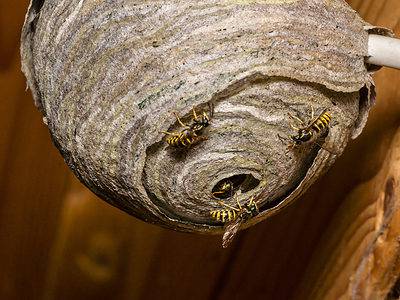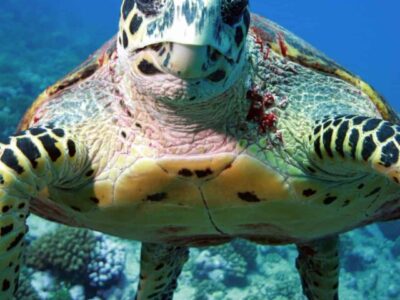Nurse Shark
Ginglymostoma cirratum
Commonly found in Central American waters!
Advertisement
Nurse Shark Scientific Classification
- Kingdom
- Animalia
- Phylum
- Chordata
- Class
- Chondrichthyes
- Order
- Orectolobiformes
- Family
- Ginglymostomatidae
- Genus
- Ginglymostoma
- Scientific Name
- Ginglymostoma cirratum
Read our Complete Guide to Classification of Animals.
Nurse Shark Conservation Status
Nurse Shark Facts
- Main Prey
- Squid, Fish, Octopus
- Habitat
- Warm waters and tropical coastal regions
- Predators
- Human, Bull Shark, Tiger Shark
- Diet
- Carnivore
- Average Litter Size
- 20
View all of the Nurse Shark images!
“Nurse sharks have smoother skin than most sharks, though it feels like sandpaper.”
Sometimes called the couch potatoes of the sea, nurse sharks are large, peaceful fish. They slowly drift along the bottom of the ocean in shallow water, sucking up food as they go. They hunt alone at night but return to the same comfortable resting place during the day to doze. Although their habitat is alongside humans, these fish are rarely harmful; they will only bite if startled or provoked. These gentle sharks are quite comfortable in zoo aquariums and can live up to 25 years in captivity.
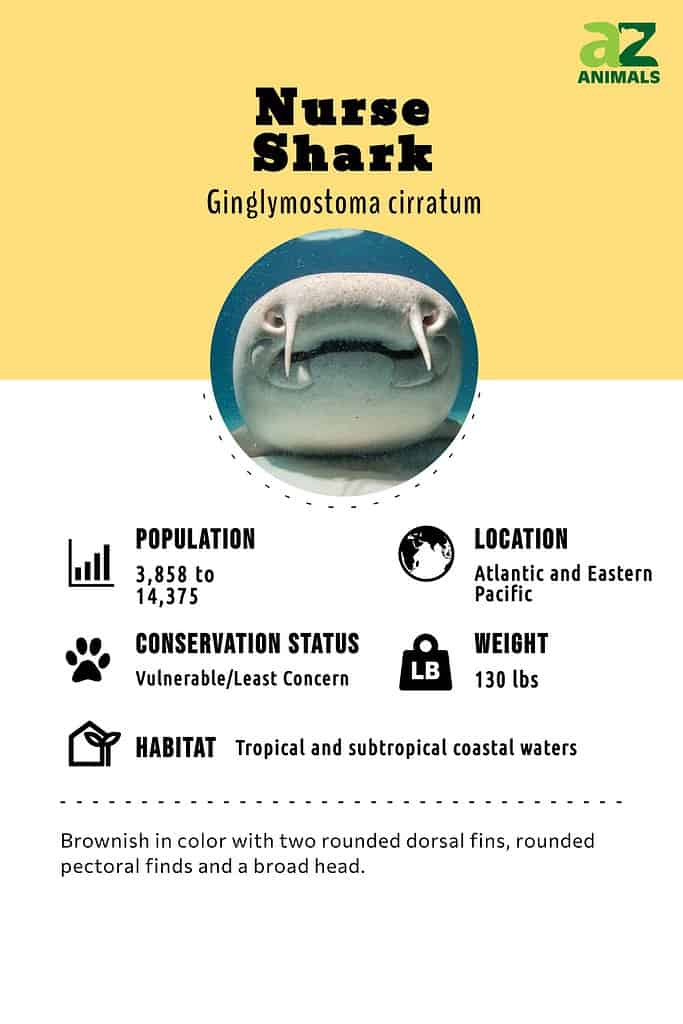
5 Nurse Shark facts
- Unlike many other shark species, the nurse shark uses the buccal pumping method to breathe. This involves the use of their oral muscles to pull water into their mouths to oxygenate their gills. It allows them to stay still and even sleep.
- These sharks don’t pose any threat to humans unless they are disturbed. In fact, many people swim right by these sharks without ever knowing they were there.
- When a school of nurse sharks finds a comfortable resting place, they return there each day after hunting. They do not migrate, as do many other fish species.
- They use their pectoral fin to “walk” across the ocean floor. Females sometimes bury their pectoral fins in the sand to avoid the mating advances of males.
- Rather than chasing prey and catching it with chomping teeth, this species swims above the ocean floor and sucks up food like a vacuum cleaner. After sucking their food into their mouths, they use rows of serrated teeth to crush it before swallowing.
Scientific name
The nurse shark is in the Ginglymostomatidae family and the Chondrichthyes class. Its scientific name, Ginglymostoma cirratum, is a mix of Greek and Latin and means “curled, hinged mouth.” This name is rather fitting because this shark always looks like he’s puckering up. Since they prefer to hover over the ocean floor, scientists believe its name came from the Old English word “hurse.” This means sea-floor shark.
Evolution Of the Species
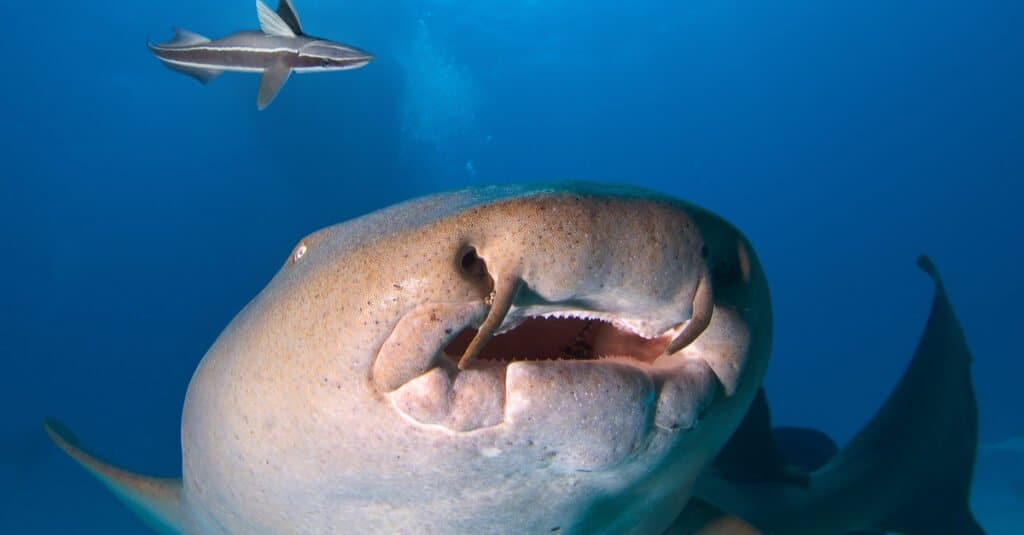
Nurse Shark is believed to have evolved from a group of spiny fish called acanthodian.
©frantisekhojdysz/Shutterstock.com
All sharks evolved from the Acanthodian, a group of spiny fish. These fish were first around over 400 million years ago, during the Palaeozoic era. This group of fish then diverted into the two main groups of fish that we now have today. These include cartilaginous fish (Chondrichthyes), of which sharks are part of, and bony fish (Osteichthyes), which includes salmon.
Types Of
The following nurse sharks should not be confused with the grey nurse shark, which is a different species (Carcharias taurus)
- Tawny nurse shark (Nebrius ferrugineus)
- Shorttail nurse shark (Pseudoginglymostoma brevicaudatum)
- Atlantic nurse shark (G. cirratum)
Appearance
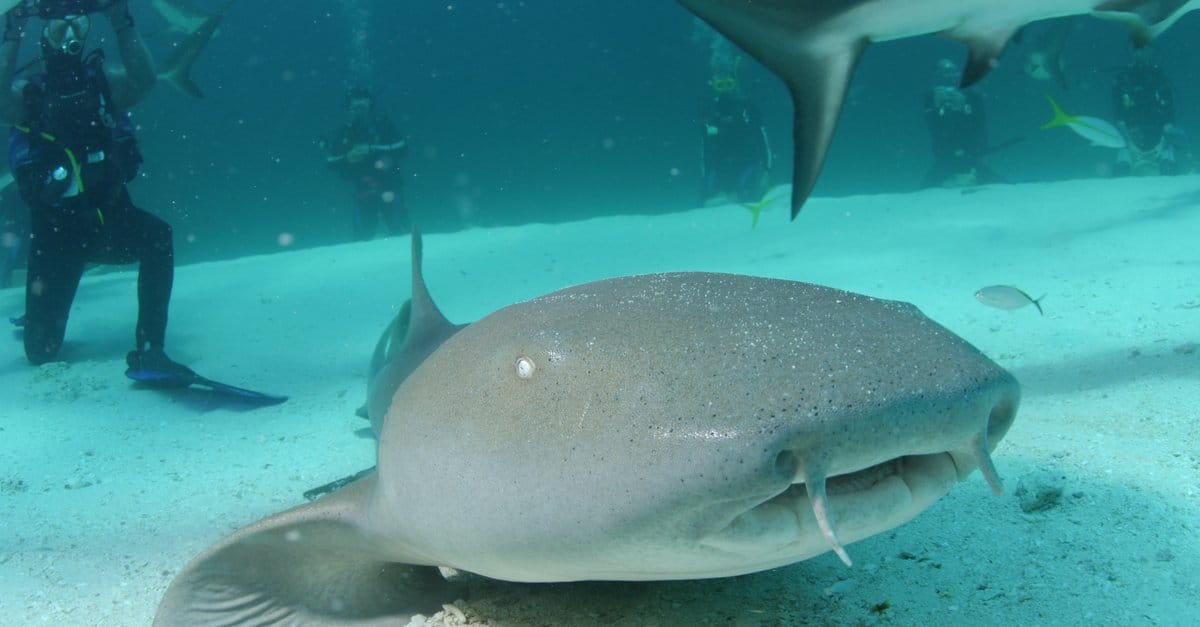
With a wide body and a short snout, the nurse shark looks different than its more dangerous cousins,
©tali de pablos/Shutterstock.com
The nurse shark has a wide body and a short snout with a small, rectangular mouth. They have two sensory organs called barbels that grow down from their upper lip. These barbels help them find small fish and crabs hiding in the sand.
This species of shark looks a bit different than many of its more dangerous cousins. Their thick skin is smoother than that of most other sharks, and their dorsal fin is round rather than sharp. Their color sets them apart from the others as well — they are tawny brown rather than grey.
These sharks grow to about 7.5 to 9 feet long and weigh between 150 and 300 pounds. The largest nurse shark on record is 14 feet long, more than two times longer than the average man’s height. They also have long tails, which can make up about a quarter of their total length.
Behavior
The nurse shark is a solitary, nocturnal hunter. However, during the day, it will probably be resting in a pile of other similarly sized sharks. These sharks don’t migrate; when they finish hunting for the night, they return to their favorite area to rest.
Habitat
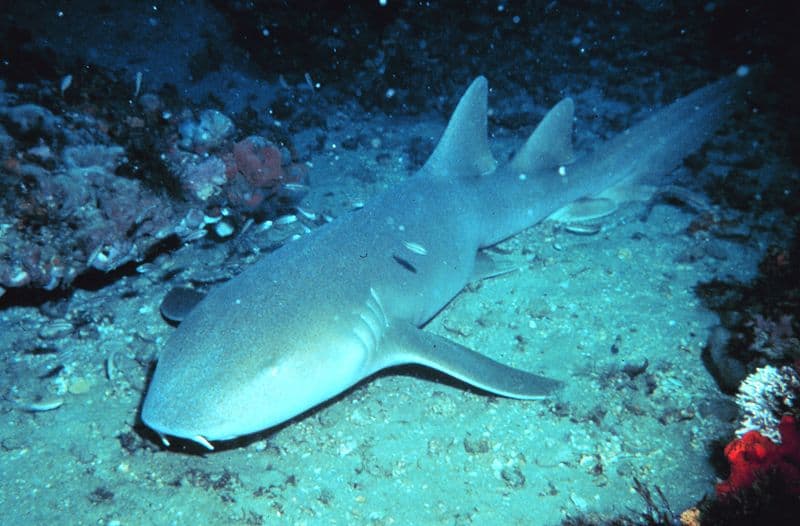
Nurse sharks prefer warm, shallow waters and live close to human activity.
©Dr. Mathew Gilligan – Public Domain by U.S. National Oceanic and Atmospheric Administration – License
Nurse sharks like warm, shallow water and live all across the eastern part of the Pacific Ocean and the western part of the Atlantic Ocean. They live in close proximity to human activity and, while they are not usually aggressive, can bite in self-defense if humans encroach on their territory.
Population
The abundance of nurse shark populations worldwide was estimated using an analysis of distance sampling. Their current numbers range from 3,858 to 14,375. However, their numbers are low in certain areas due to previous overfishing for their skin and oil. Since humans no longer routinely hunt these sharks, the species as a whole is thriving. Depending on the location, their numbers may be either vulnerable or of least concern.
Diet
A nurse shark’s mouth possesses rows of tiny, serrated teeth that can crush hard-shelled crustaceans and snails. Small fish, shellfish, shrimp, and squid are some of the nurse shark’s favorite foods, though they will also eat algae and coral from time to time. Since they hunt at night, they eat fish that are resting.
Predators And Threats
The nurse shark doesn’t have any specific predators, but it can make an easy meal for larger fish such as tiger sharks or lemon sharks. This species of shark is not a threatened or endangered species.
Reproduction, Babies, And Lifespan
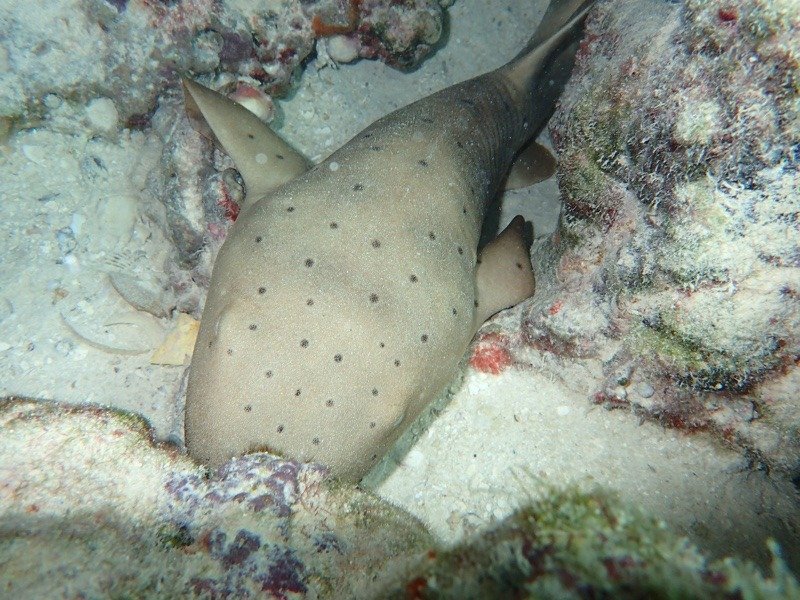
Baby nurse sharks are roughly 8 to 12 inches in length at birth.
©George P Gross/Shutterstock.com
When a nurse shark wants to mate, the male will bite the female’s pectoral fin to hold her in place for the mating process. This species is unique in its reproductive process compared to other sharks because more than one male can fertilize the same litter.
This species of shark is ovoviviparous, meaning that the female carries the fertilized eggs inside her to incubate. When the six-month incubation period comes to an end, she gives birth to a litter of about 25 live pups. These pups are roughly 8-12 inches in length when they are born. After giving birth, it takes the female 18 months to produce eggs and go through the reproductive cycle again.
In Zoos
Nurse sharks do well in captivity, possibly because they are less active than other shark species. Since they don’t need to stay swimming to breathe, they are less bothered by smaller living spaces than their more active cousins. The average lifespan for a nurse shark in captivity is up to 25 years.
You can find them at Point Defiance Zoo & Aquarium in Tacoma, Washington; Omaha’s Henry Doorly’s Zoo & Aquarium in Omaha, Nebraska; and the National Aquarium in Baltimore, Maryland to name just a few.
View all 65 animals that start with NNurse Shark FAQs (Frequently Asked Questions)
Is it safe to swim with nurse sharks?
Swimming with nurse sharks is relatively safe, but that doesn’t mean there’s no risk involved at all. Even though these slow-moving sharks are docile, you must remember that they are still wild animals and may attack if they feel threatened.
Can I pet a nurse shark?
This species of shark is usually harmless to humans, but that doesn’t mean you should try to pet them. Their mouths are small, but if you startle or step on one, they will use their sharp, serrated teeth to defend themselves.
Has a nurse shark ever killed a human?
Though their teeth are sharp and can do some damage, there is no record of a nurse shark attack resulting in the death of a human. These sharks are mostly docile and will only bite if provoked.
Are nurse sharks carnivores?
Yes, nurse sharks are carnivores. Their diet consists of small fish, shellfish and squids. Though a fisherman will occasionally find algae in their stomachs, scientists believe the sharks simply suck the algae up alongside their prey rather than intending it to be a source of food.
Are nurse sharks blind?
No, nurse sharks are not blind, but there are two species in the carpet shark order who are. All carpet sharks have similar features, so it is easy to mistake one species for another.
Are nurse sharks grey?
No, nurse sharks are tawny brown in color. Though Australia’s sand tiger shark is sometimes called a grey nurse shark, the two species have an entirely different appearance and temperament. They also live in different areas of the world, with the nurse shark living near the southern United States and the sand tiger shark living off the coast of Australia.
What Kingdom do Nurse Sharks belong to?
Nurse Sharks belong to the Kingdom Animalia.
What class do Nurse Sharks belong to?
Nurse Sharks belong to the class Chondrichthyes.
What phylum to Nurse Sharks belong to?
Nurse Sharks belong to the phylum Chordata.
What family do Nurse Sharks belong to?
Nurse Sharks belong to the family Ginglymostomatidae.
What order do Nurse Sharks belong to?
Nurse Sharks belong to the order Orectolobiformes.
What type of covering do Nurse Sharks have?
Nurse Sharks are covered in Smooth skin.
What genus do Nurse Sharks belong to?
Nurse Sharks belong to the genus Ginglymostoma.
In what type of habitat do Nurse Sharks live?
Nurse Sharks live in warm waters and tropical coastal regions.
What is the main prey for Nurse Sharks?
Nurse Sharks prey on squid, fish, and octopus.
What are some predators of Nurse Sharks?
Predators of Nurse Sharks include humans, bull sharks, and tiger sharks.
How many babies do Nurse Sharks have?
The average number of babies a Nurse Shark has is 20.
What is an interesting fact about Nurse Sharks?
Nurse Sharks are commonly found in Central American waters!
What is the scientific name for the Nurse Shark?
The scientific name for the Nurse Shark is Ginglymostoma cirratum.
What is the lifespan of a Nurse Shark?
Nurse Sharks can live for 20 to 25 years.
How fast is a Nurse Shark?
A Nurse Shark can travel at speeds of up to 25 miles per hour.
What are the differences between nurse sharks and grey nurse sharks?
The key differences between nurse sharks and grey nurse sharks are appearance, teeth, size, reproduction, habitat, and location.
Thank you for reading! Have some feedback for us? Contact the AZ Animals editorial team.
Sources
- Mark Mancini for Mental Floss, Available here: https://www.mentalfloss.com/article/559319/nurse-shark-facts
- Aquaviews, Available here: https://www.leisurepro.com/blog/explore-the-blue/carpet-bunch-7-families-carpet-sharks/
- How Stuff Works, Available here: https://animals.howstuffworks.com/fish/sharks/nurse-shark2.htm
- Wikipedia, Available here: https://en.wikipedia.org/wiki/Sand_tiger_shark










